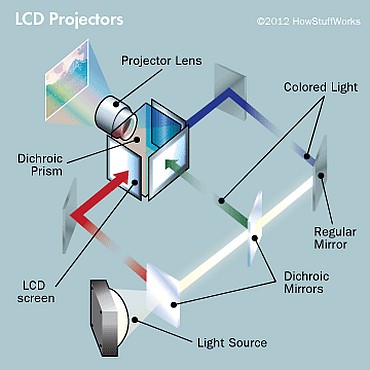The technology behind the LCD projector is nearly three decades old in 2012, but it remains one of the top digital projection technologies, alongside Digital Light Processing (DLP) projectors. Inventor Gene Dolgoff developed the first LCD projector in 1984, and both Epson and Sony continue to employ the technology in 21st century projectors.
The old method of film projection was simple: Each frame of the film was a tiny, translucent photograph. Shine light through the film and then have that light pass through an imaging lens and you’d display a larger version of that tiny image onto a wall or screen.
LCD projectors work a little differently. A beam of high-intensity light travels through thousands of shifting pixels in an LCD display instead of through a frame of translucent film. And these projectors don’t just use a single LCD display either — they use three, which is why they’re also called 3LCD projectors. The light splits into three hues, then travels through three LCDs before recombining in a prism to generate the crisp, colorful image projected on the screen.
Still sound like magic? Well, let’s walk through the process at a slower pace, beginning with the lamp and ending on the big screen.
So grab your popcorn. Settle back in your seat. Turn off your phone and prepare to break some light.
3LCD: Breaking the Light Fantastic
To understand how an LCD projector works, it’s best to start at the beginning — with a beam of light — and end on the movie screen itself.
Step one: A powerful light source emits a beam of intense, white light.
Step two: Our beam of white light bounces off a group of mirrors that includes two dichroic mirrors, which are coated in a special film that reflects only a specified wavelength of light. You know how a prism (or a droplet of water) breaks a beam of light into distinct wavelengths (or a rainbow of colors)? The same principle applies here, only each dichroic mirror breaks off a single specified wavelength. So the white light hits the mirrors, and each reflects a beam of colored light on through the projector: one red, one green and one blue.
Step three: The beams of red, green and blue light each pass through a liquid crystal display composed of thousands of tiny pixels. You can read How Liquid Crystal Displays Work for a more detailed explanation of LCD technology, but it comes down to tiny, colorless pixels that either block light or allow it to pass through when triggered by an electric current. All three of the LCD screens in the projector display the same image or moving images, only in gray scale. When the colored light passes through these three screens, they relay three versions of the same scene: one tinted red, one tinted green and one tinted blue.
Step four: But of course the final image we see isn’t red, green or blue; it’s full color. So inside the LCD projector, the three tinted versions of this scene recombine in a dichroic prism (a finely crafted combination of four triangular prisms) to form a single image composed of not three colors but millions of colors.
Step five: The light of this vibrant, colorful version of the scene then passes through a projector lens and onto the big screen.
For more Detail: How LCD Projectors Work

